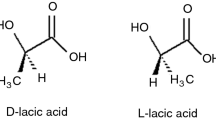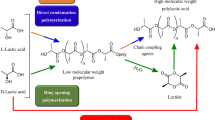Abstract
A environment-friendly polymer blends were prepared by the basis of bio-sourced polylactide (PLA) and aliphatic poly(butylene succinate) (PBS) via melt compounding process. 1,4-butanediol and succinic acid was used together with tetrabutyltitanate as catalyst to synthesize PBS via esterified and polycondensation. The chemical structure of PBS was studied by 1H NMR and FT-IR spectroscopy. The effects PBS content on thermal behavior, mechanical properties, phase morphology, and thermal stability of PLA/PBS blends were systematically investigated. DSC and DMA results showed that glass transition temperature (Tg) and cool crystallizaiton temperature (Tcc) of PLA was influenced by PBS. The different phase morphologies of the PLA/PBS blends formed after addition of PBS into PLA. The various phase morphologies from that blend influenced the rheological behavior and further influenced the mechanical properties in PLA/PBS blends, the well dispersed PBS increased the elongation at break of 8.1 ± 0.1 kJ/m2 with around 80.0% over than neat the PLA. Finally, the PLA/PBS blends have excellent mechanical and thermal properties by analyzing the toughening mechanism and crystallization morphology.
Graphical Abstract














Similar content being viewed by others
References
Wang H, Chen X, Ding Y, Huang D, Ma Y, Pan L, Zhang K, Wang H (2021) Combining novel polyether-based ionomers and polyethylene glycol as effective toughening agents for polylactide. Polymer 229:123964
Benson NU, Bassey DE, Palanisami T (2021) COVID pollution: impact of COVID-19 pandemic on global plastic waste footprint. Heliyon 7(2):e06343
Azara A, Belbessai S, Abatzoglou N (2022) A review of filamentous carbon nanomaterial synthesis via catalytic conversion of waste plastic pyrolysis products. J Environ Chem Eng 10(1):107049
Lim BKH, Thian ES (2022) Biodegradation of polymers in managing plastic waste: a review. Sci Total Environ 813:151880
Tyagi P, Agate S, Velev OD, Lucia L, Pal L (2022) A Critical review of the performance and soil biodegradability profiles of biobased natural and chemically synthesized polymers in industrial applications. Environ Sci Technol 56(4):2071–2095
Taib N-AAB, Rahman MR, Huda D, Kuok KK, Hamdan S, Bakri MKB, Julaihi MRMB, Khan A (2022) A review on poly lactic acid (PLA) as a biodegradable polymer. Polym Bull. https://doi.org/10.1007/s00289-022-04160-y
Aliotta L, Sciara LM, Cinelli P, Canesi I, Lazzeri A (2022) Improvement of the PLA crystallinity and heat distortion temperature optimizing the content of nucleating agents and the injection molding cycle time. Polymers 14(5):977
Ren Q, Wu M, Wang L, Zheng W, Hikima Y, Semba T, Ohshima M (2022) Cellulose nanofiber reinforced poly (lactic acid) with enhanced rheology, crystallization and foaming ability. Carbohydr Polym 286:119320
Zamir SS, Fathi B, Ajji A, Robert M, Elkoun S (2022) Biodegradation of modified starch/poly lactic acid nanocomposite in soil. Polym Degrad Stab 199:109902
Hu XR, Li Y, Gao Y, Wang R, Wang Z, Kang H, Zhang L (2019) Renewable and super-toughened poly (butylene succinate) with bio-based elastomers: preparation, compatibility and performances. Eur Polym J 116:438–444
Xu Y, Zhang S, Peng X, Wang J (2018) Fabrication and mechanism of poly (butylene succinate) urethane ionomer microcellular foams with high thermal insulation and compressive feature. Eur Polym J 99(9):250–258
Jariyasakoolroj P, Chirachanchai S (2022) In situ chemical modification of thermoplastic starch with poly(L-lactide) and poly (butylene succinate) for an effectively miscible ternary blend. Polymers 14(4):825
Zhou M, Zhang K, Jiang Z, Qiu Z (2021) Synthesis and characterization of novel poly (butylene succinate)-b-poly (diethylene glycol terephthalate) multiblock copolyesters with high melting point and significantly improved mechanical property. Polymer 232:124151
Peñas MI, Pérez-Camargo RA, Hernandez R, Muller AJ (2022) A review on current Strategies for the modulation of thermomechanical, barrier, and biodegradation properties of poly (Butylene Succinate) (PBS) and its random copolymers. Polymers 14(5):1025
Di Lorenzo ML, Androsch R, Righetti MC (2017) Low-temperature crystallization of poly (butylene succinate). Eur Polym J 94:384–391
Tachibana Y, Masuda T, Funabashi M, Kunioka M (2010) Chemical synthesis of fully biomass-based poly (butylene succinate) from inedible-biomass-based furfural and evaluation of its biomass carbon ratio. Biomacromol 11(10):2760–2765
Wang X, Zhou J, Li L (2007) Multiple melting behavior of poly (butylene succinate). Eur Polym J 43(8):3163–3170
Rosenboom JG, Langer R, Traverso G (2022) Bioplastics for a circular economy. Nat Rev Mater 7:117–137
Garin M, Tighzert L, Vroman I, Marinkovic S, Estrine B (2014) The kinetics of poly (butylene succinate) synthesis and the influence of molar mass on its thermal properties. J Appl Polym Sci 131(16):40639
Cui CN, Huang JT (2012) Synthesis and characterization of poly (butylenes succinate) with control different end-group. Adv Mater 430:497–500
Han YK, Kim J, Kim SR (2002) Preparation and characterization of high molecular weight poly (butylene succinate). Macromol Res 10(2):108–114
Velmathi S, Nagahata R, Sugiyama JI, Takeuchi K (2005) A rapid eco-friendly synthesis of poly (butylene succinate) by a direct polyesterification under microwave irradiation. Macromol Rapid Commun 26(14):1163–1167
Gkountela C, Rigopoulou M, Barampouti EM, Vouyiouka S (2021) Enzymatic prepolymerization combined with bulk post-polymerization towards the production of bio-based polyesters: The case of poly (butylene succinate). Eur Polym J 143:110197
Zhao X, Zhang D, Yu S, Zhou H, Peng S (2021) Recent advances in compatibility and toughness of poly (lactic acid)/poly (butylene succinate) blends. E-Polymers 21(1):793–810
Chuayjuljit S, Wongwaiwattanakul C, Chaiwutthinan P, Prasassarakich P (2017) Biodegradable poly (lactic acid)/poly (butylene succinate)/wood flour composites: Physical and morphological properties. Polym Compos 38(12):2841–2851
Hassan EAM, Elarabi SE, Wei Y, Yu M (2017) Biodegradable poly (lactic acid)/poly (butylene succinate) fibers with high elongation for health care products. Text Res J 88(15):1735–1744
Deng Y, Thomas NL (2015) Blending poly (butylene succinate) with poly (lactic acid): ductility and phase inversion effects. Eur Polym J 71:534–546
Su S, Kopitzky R, Tolga S, Kabasci S (2019) Polylactide (PLA) and its blends with poly (butylene succinate) (PBS): a brief review. Polymer 11(7):1193
Hu X, Su T, Li P, Wang Z (2017) Blending modification of PBS/PLA and its enzymatic degradation. Polym Bull 75(2):533–546
Shibata M, Inoue Y, Miyoshi M (2006) Mechanical properties, morphology, and crystallization behavior of blends of poly(l-lactide) with poly (butylene succinate-co-l-lactate) and poly (butylene succinate). Polymer 47(10):3557–3564
Ojijo V, Ray SS, Sadiku R (2013) Toughening of biodegradable polylactide/poly (butylene succinate-co-adipate) blends via in situ reactive compatibilization. ACS Appl Mater Interfaces 5(10):4266–4276
Papageorgiou DG, Chrissafis K, Pavlidou E, Deliyanni EA, Papageorgiou GZ, Terzopoulou Z, Bikiaris DN (2014) Effect of nanofiller’s size and shape on the solid state microstructure and thermal properties of poly (butylene succinate) nanocomposites. Thermochim Acta 590:181–190
Alemán C, Lotz B, Puiggali J (2001) Crystal structure of the α-form of poly(L-lactide). Macromolecules 34(14):4795–4801
Sasaki S, Asakura T (2003) Helix distortion and crystal structure of the α-form of poly(L-lactide). Macromolecules 36(22):8385–8390
Aravind I, Boumod A, Grohens Y, Thomas S (2010) Morphology, dynamic mechanical, thermal, and crystallization behaviors of poly (trimethylene terephthalate)/polycarbonate blends. Ind Eng Chem Res 49(8):3873–3882
Li Y, Han C, Yu Y, Huang D (2019) Morphological, thermal, rheological and mechanical properties of poly (butylene carbonate) reinforced by stereocomplex polylactide. Int J Biol Macromol 137:1169–1178
Xu LQ, Huang HX (2012) Relaxation behavior of poly (lactic acid)/poly (butylene succinate) blend and a new method for calculating its interfacial tension. J Appl Polym Sci 125(S2):E272–E277
Acknowledgements
This work was supported by Jilin Provincial Science and Technology Department Project (No.20220203019SF), Jilin Provincial Development and Reform Commission Project (No.2022C039-3), Science and Technology Bureau of Jilin Province of China (No.20210509017RQ), Program of Changchun Science and Technology Bureau (No. 21KY01), and the Natural Science Foundation of Hebei Province, China (E2021202035).
Author information
Authors and Affiliations
Corresponding authors
Ethics declarations
Conflict of interest
No conflict of interest exists in the submission of this manuscript, and the manuscript is approved by all authors for publication. We declare that we do not have any commercial or associative interest that represents a conflict of interest in connection with the work submitted.
Additional information
Publisher's Note
Springer Nature remains neutral with regard to jurisdictional claims in published maps and institutional affiliations.
Rights and permissions
Springer Nature or its licensor (e.g. a society or other partner) holds exclusive rights to this article under a publishing agreement with the author(s) or other rightsholder(s); author self-archiving of the accepted manuscript version of this article is solely governed by the terms of such publishing agreement and applicable law.
About this article
Cite this article
Zhao, T., Yu, J., zhang, X. et al. Thermal, crystallization, and mechanical properties of polylactic acid (PLA)/poly(butylene succinate) (PBS) blends. Polym. Bull. 81, 2481–2504 (2024). https://doi.org/10.1007/s00289-023-04848-9
Received:
Revised:
Accepted:
Published:
Issue Date:
DOI: https://doi.org/10.1007/s00289-023-04848-9




